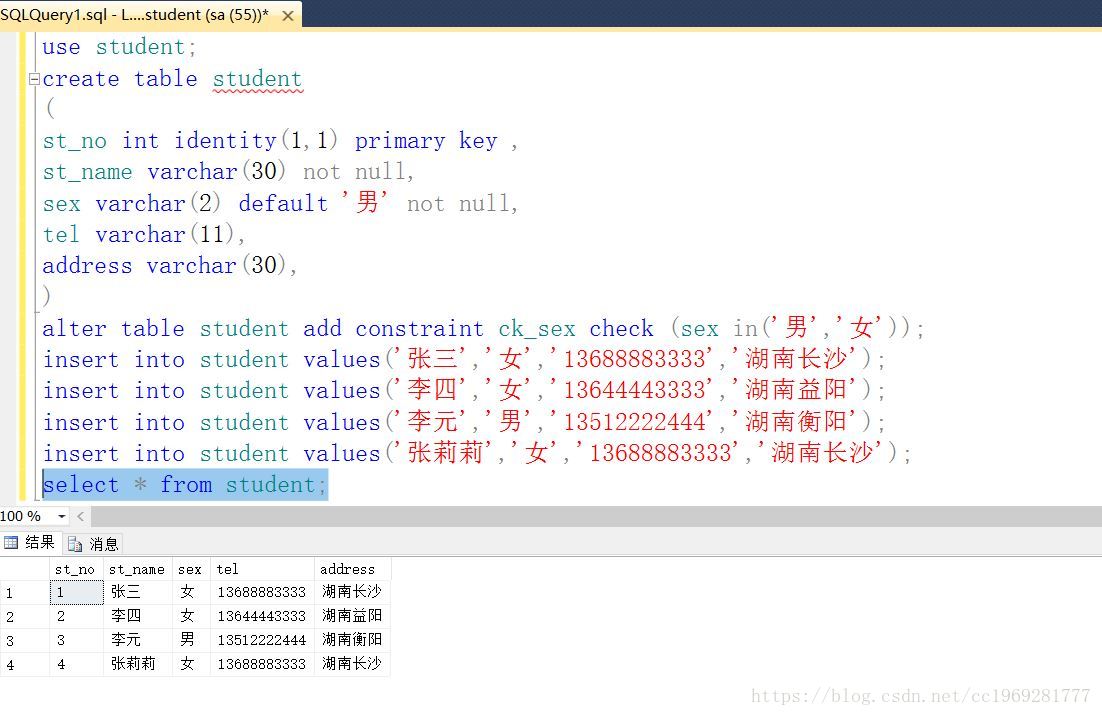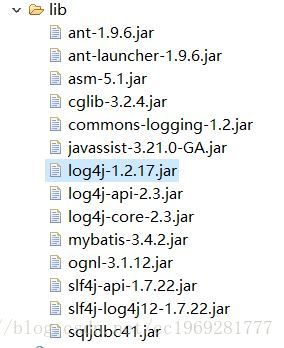MyBatis在操作数据库时,主要分为8大步骤:
(1) 读取MyBatis配置文件mabatis-config.xml,mabatis-config.xml作为MaBatis的全局配置文件,配置了MyBatis的运行环境等信息,其主要是获取数据库连接。
(2) 加载映射文件Mapper.xml。Mapper.xml即SQL映射文件,该文件配置了操作数据库的SQL语句,需要在mybatis-config.xml中加载才能执行。mybatis-config.xml可以添加多个配置文件,每个配置文件对应数据库中的一张表。
(3) 构建会话工厂。通过MyBatis的环境等配置信息构建会话工厂SqlSessionFactory。
(4) 创建SqlSession对象。由会话工厂创建SqlSession对象。,该对象中包含执行SQL的所有方法。
(5) MyBatis底层定义的一个Executor接口会根据SqlSession传递的参数动态生成SQL语句,同时负责查询缓存的维护。
(6) 根据生成的SQL语句生成MappedStatement对象。
(7) 向MappedStatement输入映射对象,这里的输入参数的映射过程就相当于JDBC编程中对preparedStatement对象设置参数的过程。
(8) 执行SQL语句,对MappedStatement对象返回的结果进行处理。
下面通过一个入门程序来理解。
1.根据学号查询学生信息
(1)这里用sql server数据库。
在SQL Server数据库中,创建一个名为student的数据库,创建一个student表,并插入几条数据。
创建代码:
- create database student;
- use student;
- create table student
- (
- st_no int identity(1,1) primary key ,
- st_name varchar(30) not null,
- sex varchar(2) default '男' not null,
- tel varchar(11),
- address varchar(30),
- )
- alter table student add constraint ck_sex check (sex in('男','女'));
- insert into student values('张三','女','13688883333','湖南长沙');
- insert into student values('李四','女','13644443333','湖南益阳');
- insert into student values('李元霸','男','13512222444','湖南衡阳');
- insert into student values('张莉莉','女','13688883333','湖南长沙');
- select * from student;

(2)在Myeclipse创建一个名为project01的Web项目,将MyBatis的核心jar包、依赖包,以及Sql Server数据库驱动添加到项目的lib目录下。

(3)在src目录下创建log4j.properties文件,内容如下 :
- # Global logging configuration
- log4j.rootLogger=ERROR, stdout
- # MyBatis logging configuration...
- log4j.logger.cn.swjd=DEBUG
- # Console output...
- log4j.appender.stdout=org.apache.log4j.ConsoleAppender
- log4j.appender.stdout.layout=org.apache.log4j.PatternLayout
- log4j.appender.stdout.layout.ConversionPattern=%5p [%t] - %m%n
MyBatis默认使用log4j输出日志信息,如果要在控制台查看sql语句,就必须
在src目录下创建log4j.properties文件。
(4)在src目录下创建cn.swjd.entries包,在该包下创建持久化类Student。
- package cn.swjd.entries;
- //学生持久化类
- public class Student {
- //主键学号
- private Integer st_no;
- //姓名,性别,年龄,电话 ,地址
- private String st_name, sex, tel, address;
- public Integer getSt_no() {
- return st_no;
- }
- public void setSt_no(Integer st_no) {
- this.st_no = st_no;
- }
- public String getSt_name() {
- return st_name;
- }
- public void setSt_name(String st_name) {
- this.st_name = st_name;
- }
- public String getSex() {
- return sex;
- }
- public void setSex(String sex) {
- this.sex = sex;
- }
- public String getTel() {
- return tel;
- }
- public void setTel(String tel) {
- this.tel = tel;
- }
- public String getAddress() {
- return address;
- }
- public void setAddress(String address) {
- this.address = address;
- }
- @Override
- public String toString() {
- return "Student [st_no=" + st_no + ", st_name=" + st_name + ", sex="
- + sex + ", tel=" + tel + ", address=" + address + "]";
- }
- }
(5)在src目录下。创建cn.swjd.mapper包,在包里创建映射文件StudentMapper.xml。
- <?xml version="1.0" encoding="UTF-8" ?>
- <!DOCTYPE mapper PUBLIC "-//mybatis.org//DTD Mapper 3.0//EN"
- "http://mybatis.org/dtd/mybatis-3-mapper.dtd">
- <mapper namespace="cn.swjd.mapper.StudentMapper">
- <select id="findStudentById" parameterType="Integer" resultType="cn.swjd.entries.Student">
- select * from student where st_no= #{st_no}
- </select>
- </mapper>
说明:<mapper>元素是配置文件的根元素,它包含一个namespace属性,该属性指定了<mapper>的唯一命名空间,通常设置为“包名+SQL映射文件名”的形式。
子元素<select>中的信息是用于执行查询操作的配置,id是唯一标识符。
parameterType:指定传入参数的类型。
resultType:指定返回结果的类型。
#{}:表示一个占位符,相当于jdbc中的?,其里面的内容为接受参数的名称。
(6)在src目录下,创建MyBatis的核心配置文件mybatis-config.xml。
- <?xml version="1.0" encoding="UTF-8" ?>
- <!DOCTYPE configuration PUBLIC "-//mybatis.org//DTD Config 3.0//EN"
- "http://mybatis.org/dtd/mybatis-3-config.dtd">
- <configuration>
- <environments default="sqlserver">
- <environment id="sqlserver">
- <transactionManager type="JDBC"/>
- <!-- 配置数据库连接池 -->
- <dataSource type="POOLED">
- <property name="driver" value="com.microsoft.sqlserver.jdbc.SQLServerDriver"/>
- <property name="url" value="jdbc:sqlserver://localhost:1433;DataBaseName=student"/>
- <property name="username" value="sa"/>
- <property name="password" value="123"/>
- </dataSource>
- </environment>
- </environments>
- <mappers>
- <mapper resource="cn/swjd/mapper/StudentMapper.xml"/>
- </mappers> </configuration>
说明:
<environments>下可配置多个运行环境,default属性用于设置默认运行环境。
(7)在src目录下,创建一个cn.swjd.test包,创建测试类MyBatisTest,再编写一个方法findStudentByIdTest(int st_id),并在main方法里调用。
- package cn.swjd.test;
- import java.io.IOException;
- import java.io.InputStream;
- import org.apache.ibatis.io.Resources;
- import org.apache.ibatis.session.SqlSession;
- import org.apache.ibatis.session.SqlSessionFactory;
- import org.apache.ibatis.session.SqlSessionFactoryBuilder;
- import cn.swjd.entries.Student;
- public class MyBatisTest {
- public static void findStudentByIdTest(int st_id) throws Exception{
- //1.读取配置文件
- String resource="mybatis-config.xml";
- InputStream inputstream=Resources.getResourceAsStream(resource);
- //2.根据配置文件构建SqlSessionFactory
- SqlSessionFactory factory=new SqlSessionFactoryBuilder().build(inputstream);
- //3.通过SqlSessionFactory构建SqlSession
- SqlSession sqlsession=factory.openSession();
- //4.SqlSession执行映射文件中定义的SQL,并返回其映射结果
- Student s=sqlsession.selectOne("cn.swjd.mapper.StudentMapper.findStudentById",st_id);
- //打印输出结果
- System.out.println(s.toString());
- }
- public static void main(String args[]) throws Exception{
- findStudentByIdTest(1);
- }
-
- }
运行结果:

2.根据姓名模糊查询学生信息
修改映射文件StudentMapper.xml,添加一个<select>
<select id="findStudentByName" parameterType="String" resultType="cn.swjd.entries.Student">
select * from student where st_name like '%${value}%'
</select>
这里传入参数为什么不设置为#{}而用${}呢?
假设传入参数在程序里为 String value=”张”;
如果使用的是#{},最终的sql语句就会变成:
select * from student where st_name like ‘’张’’
使用${},最终的sql语句就会变成:
select * from student where st_name like ‘张’
原因:如果使用的是#{},传入参数?就会根据配置文件<select>中parameterType属性(即数据类型)自动变换,如果parameterType="String",就会自动加入’’, 如果parameterType="Integer",就不会加’’。
而使用${} 不管parameterType属性为何值,都不会自动加’’。
在类MyBatisTest,编写一个方法findStudentByNameTest(String value),并在main方法里调用。
- public static void findStudentByNameTest(String st_name) throws Exception{
- //1.读取配置文件
- String resource="mybatis-config.xml";
- InputStream inputstream=Resources.getResourceAsStream(resource);
- //2.根据配置文件构建SqlSessionFactory
- SqlSessionFactory factory=new SqlSessionFactoryBuilder().build(inputstream);
- //3.通过SqlSessionFactory构建SqlSession
- SqlSession sqlsession=factory.openSession();
- //4.SqlSession执行映射文件中定义的SQL,并返回其映射结果
- List<Student> s=sqlsession.selectList("cn.swjd.mapper.StudentMapper.findStudentByName",st_name);
- /*selectList方法第一个参数为<Mapper>的namespace属性+<select>的id属性,后面接传入参数*/
- //打印输出结果
- for(Student stu:s)
- System.out.println(stu.toString());
- }
- public static void main(String args[]) throws Exception{
- findStudentByNameTest("张");
- }
运行结果:

结果出来了,但是这里有一个问题,使用“${}”拼接字符串,无法防止sql注入问题。
比如这里,如果把方法调用改成:
findStudentByNameTest("1';delete from student where st_no>0;commit; select * from student where st_name like '”);


它竟然可以操作数据库!把表所有内容都删除了。显然,实际项目开发中,是不能出现这种bug的,你永远不知道用户会输入什么东西。
所以,为了安全性,这里不能用${},只能用#{},我们可以用SqlServer中的拼接函数concat()。
修改后:
select * from student where st_name like concat('%',#{value},'%')
修改、删除、增加操作都差不多
相比于查询,就是多了sqlsession.commit()提交事务这一步骤而已
- <?xml version="1.0" encoding="UTF-8" ?>
- <!DOCTYPE mapper PUBLIC "-//mybatis.org//DTD Mapper 3.0//EN"
- "http://mybatis.org/dtd/mybatis-3-mapper.dtd">
- <mapper namespace="cn.swjd.mapper.StudentMapper">
- <!-- 根据学号查询学生信息 -->
- <select id="findStudentById" parameterType="Integer" resultType="cn.swjd.entries.Student">
- select * from student where st_no= #{st_no}
- <!-- 根据姓名模糊查询学生信息 -->
- </select>
- <select id="findStudentByName" parameterType="String" resultType="cn.swjd.entries.Student">
- select * from student where st_name like concat('#',#{value},'#')
- </select>
- <!-- 更新学生信息 -->
- <update id="updateStudent" parameterType="cn.swjd.entries.Student"
- >
- update student set st_name=#{st_name},sex=#{sex},tel=#{tel},address=#{address} where st_no=#{st_no}
- </update>
- <!-- 删除学生信息 -->
- <delete id="deleteStudent" parameterType="Integer">
- delete from student where st_no=#{id}
- </delete>
- <!-- 增加学生信息 -->
- <insert id="addStudent" parameterType="cn.swjd.entries.Student">
- insert into student values (#{st_name},#{sex},#{tel},#{address})
- </insert>
- </mapper>
- package cn.swjd.test;
- import java.io.IOException;
- import java.io.InputStream;
- import java.util.List;
-
- import org.apache.ibatis.io.Resources;
- import org.apache.ibatis.session.SqlSession;
- import org.apache.ibatis.session.SqlSessionFactory;
- import org.apache.ibatis.session.SqlSessionFactoryBuilder;
-
- import cn.swjd.entries.Student;
- public class MyBatisTest {
- //根据学号查找学生
- public static void findStudentByIdTest(int st_id) throws Exception{
- //1.读取配置文件
- String resource="mybatis-config.xml";
- InputStream inputstream=Resources.getResourceAsStream(resource);
- //2.根据配置文件构建SqlSessionFactory
- SqlSessionFactory factory=new SqlSessionFactoryBuilder().build(inputstream);
- //3.通过SqlSessionFactory构建SqlSession
- SqlSession sqlsession=factory.openSession();
- //4.SqlSession执行映射文件中定义的SQL,并返回其映射结果
- Student s=sqlsession.selectOne("cn.swjd.mapper.StudentMapper.findStudentById",st_id);
- /*selectOne方法第一个参数为<Mapper>的namespace属性+<select>的id属性,后面接传入参数*/
- //打印输出结果
- System.out.println(s.toString());
- }
- //根据姓名模糊查找学生
- public static void findStudentByNameTest(String st_name) throws Exception{
- //1.读取配置文件
- String resource="mybatis-config.xml";
- InputStream inputstream=Resources.getResourceAsStream(resource);
- //2.根据配置文件构建SqlSessionFactory
- SqlSessionFactory factory=new SqlSessionFactoryBuilder().build(inputstream);
- //3.通过SqlSessionFactory构建SqlSession
- SqlSession sqlsession=factory.openSession();
- //4.SqlSession执行映射文件中定义的SQL,并返回其映射结果
- List<Student> s=sqlsession.selectList("cn.swjd.mapper.StudentMapper.findStudentByName",st_name);
- /*selectList方法第一个参数为<Mapper>的namespace属性+<select>的id属性,后面接传入参数*/
- //打印输出结果
- for(Student stu:s)
- System.out.println(stu.toString());
- }
- //更新学生信息
- public static void updateStudent(Student s) throws IOException{
- //1.读取配置文件
- String resource="mybatis-config.xml";
- InputStream inputstream=Resources.getResourceAsStream(resource);
- //2.根据配置文件构建SqlSessionFactory
- SqlSessionFactory factory=new SqlSessionFactoryBuilder().build(inputstream);
- //3.通过SqlSessionFactory构建SqlSession
- SqlSession sqlsession=factory.openSession();
- //4.SqlSession执行映射文件中定义的SQL,并返回其映射结果
- int i = sqlsession.update("cn.swjd.mapper.StudentMapper.updateStudent", s);
- //提交事务
- sqlsession.commit();
- if(i>0){
- System.out.println("更新学号为"+s.getSt_no()+"学生信息成功!");
- }
- }
- //删除学生信息
- public static void deleteStudent(int st_no) throws IOException{
- //1.读取配置文件
- String resource="mybatis-config.xml";
- InputStream inputstream=Resources.getResourceAsStream(resource);
- //2.根据配置文件构建SqlSessionFactory
- SqlSessionFactory factory=new SqlSessionFactoryBuilder().build(inputstream);
- //3.通过SqlSessionFactory构建SqlSession
- SqlSession sqlsession=factory.openSession();
- //4.SqlSession执行映射文件中定义的SQL,并返回其映射结果
- int i = sqlsession.delete("cn.swjd.mapper.StudentMapper.deleteStudent", st_no);
- //5.提交事务
- sqlsession.commit();
- if(i>0){
- System.out.println("删除学号为"+st_no+"的学生信息成功!");
- }
-
- }
- //增加学生信息
- public static void addStudent(Student s) throws IOException{
- //1.读取配置文件
- String resource="mybatis-config.xml";
- InputStream inputstream=Resources.getResourceAsStream(resource);
- //2.根据配置文件构建SqlSessionFactory
- SqlSessionFactory factory=new SqlSessionFactoryBuilder().build(inputstream);
- //3.通过SqlSessionFactory构建SqlSession
- SqlSession sqlsession=factory.openSession();
- //4.SqlSession执行映射文件中定义的SQL,并返回其映射结果
- int i = sqlsession.insert("cn.swjd.mapper.StudentMapper.addStudent", s);
- //5.提交事务
- sqlsession.commit();
- if(i>0){
- System.out.println("添加一条学生信息成功!");
- }
- }
- public static void main(String args[]) throws Exception{
- Student s=new Student();
- s.setSt_name("李云瑞");
- s.setSex("男");
- addStudent(s);
- }
-
- }






 本文详细介绍MyBatis操作数据库的八大步骤,包括配置、映射、会话管理及SQL执行流程。并通过具体实例演示如何实现学生信息的增删改查,深入解析参数传递、SQL动态生成与执行技巧。
本文详细介绍MyBatis操作数据库的八大步骤,包括配置、映射、会话管理及SQL执行流程。并通过具体实例演示如何实现学生信息的增删改查,深入解析参数传递、SQL动态生成与执行技巧。
















 536
536

 被折叠的 条评论
为什么被折叠?
被折叠的 条评论
为什么被折叠?








